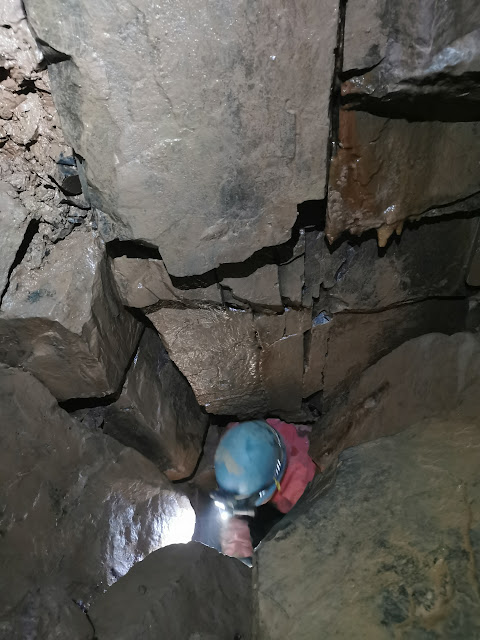After spending Sunday morning cleaning mould and plaster dust from bunks, in preparation for SWCC going back to normal operations, we didn’t have much time for a big trip, so we decided to go investigate a hole in the floor beyond Big Chamber.
 |
| De-moulding the bunkrooms |
We’d found this hole on a previous trip, when we were looking for a tight miserable crawl through hanging death. Instead of finding hanging death, we found a hole in the passage, with a traverse off to the left, which neither of us could remember. From the top of said hole, it looked like a fair drop. It was probably a very easy drop down, but self-preservation won over bravery, and we’d agreed to return another day with a rope.
 |
| The tempting hole |
So on Sunday afternoon, we headed off to check it out. The survey wasn’t giving many clues, the pitch / climb appears not to be marked, and the survey didn’t quite agree with our recollection of the layout. My wellies had disappeared, so I was caving on ice skates borrowed from the tackle store. Caving on ice skates is not to be recommended!
Paul rigged up a safety line so he could go check out the traverse. From the passage, it looked very tempting, but as we’d guessed from the location, it rapidly crapped out.
 |
The View to Nowhere
|
We then dropped down the pitch. You drop a metre or two onto a boulder a couple of feet square, then descend through a hole, and after a short free hang, you’re done. For me, definitely a pitch not a free climb.
 |
| Paul descending the hole in the floor |
We’d dropped into a boulder chamber, with several hopefully looking routes out, however, most lead to disappointment.
 |
Investigating beaver sized holes
|
We found a collection of passages that fizzled out, or were only passable if you were the size of a beaver. The only way on appears to be down another hole in the floor, but we’d failed to bring any spare rope, so that will have to wait for another day.
 |
| Paul investigating a blind climb, using the head-jam method of levitation |
 |
| Another tempting no exit |
The only consolation was that this area contains cave chocolate, unusual types of formation. Some loose rocks were clearly made from After Eight mints. Seeing as we weren’t entirely sure where we were, we shall hereby name this place After Eight Chamber.  |
| Cave confectionery in after eight chamber |
One of the side passages led mainly to formations made of chocolate covered cornflakes.
 |
| Cave cornflakes |
As we were thwarted in our mission by an unexpected pitch, we decided to resume our hunt for hanging death. Somewhere, not on the survey, is a link from Big Chamber to the passageways taking you to the Columns via the SRT route. We reckoned hanging death was to be found around there, so we ditched our SRT kits and headed up to the top of Big Chamber for a crawl around.
 |
Dropping into Hanging Death
|
We reckoned hanging death was to be found around there, so we ditched our SRT kits and headed up to the top of Big Chamber for a crawl around.
Sure enough, on looking in the most unlikely of places, we found the right barely-body size holes between boulders, and crawled and wriggled our way through a boulder choke. |
| Wriggling through the choke |
 |
| Finally room to sit up |
Paul sounded very pleased when he entered a chamber and saw tape. firstly, the end of crawling through miserable, second, tape normally signifies something pretty to see. In this case, i think the person doing the taping, I'm guessing Dave Dobson, has done a great job. Instead of the normal stal, there is a lot of mud taped off. My phone did not do justice, but there is a strange beauty about undisturbed cave mud, as well as the scientific value. It was also good to see mud preserved in places where sensible people don't bother going.
Beautifully preserved mud
 |
| A fine mud drip indent |
We turned round and completed the Beyond Big Chamber round trip (recommended for taking people that have upset you). On our way out, we mused over geological features and attempted to work out what we were seeing. Andy Freem’s training led to more questions than we have answers for, but it certainly gave us greater knowledge to ponder over.
 |
| Interesting colours to ponder |